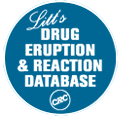Black Henna is henna plus paraphenylenediamine (PPD). PPD is added to henna to make it stain black. PPD is a transdermal toxin and may be used alone as hair dye or to stain skin black. Other products called 'black henna' may have indigo or food dyes added, and are generally not harmful to the skin.
Adverse side effects to pure henna are rare; those reported above may be due to additives. Henna tattoos were popularized by the singer, Madonna. Her black patterns, however, were created with body paint, not henna.




